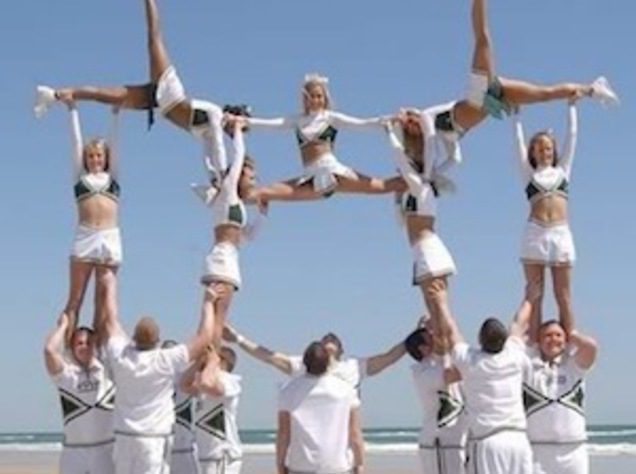Cheerleading is so much more than leading cheers. To millions of women, girls, and even young men, it’s completion. It’s gymnastics. It’s exercise. It’s pride and self-respect.
Many young prospects attend local sporting events that feature cheerleaders. There they can study the cheerleaders. If they decide they want to cheer, the next step is taking lessons or joining a team. Formal and structured cheerleading classes can be found anywhere in the country.
Beginning to Cheer
It takes commitment to become an accomplished cheerleader. It also requires a financial and time investment. Those who want to take up the activity must first decide to put in the work.
Getting Started
Many people identify cheerleaders as people who do just that: lead cheers. And for more than 100 years, they have! Cheerleaders bring spirit and energy to thousands of youth, high school, college, and professional sporting events every year. These days, however, many cheerleaders have taken to competing themselves.
Competitive cheerleading mixes elements of dance, gymnastics, and traditional cheerleading. At a competition, cheerleading teams representing a school or an independent club perform high-enery, acrobatic routines while an upbeat song plays. Like traditional cheerleaders, competitive cheerleaders often use their voices to chant and their arms, legs, and hands for motions. They something even use props such as pompoms, megaphones, hnd-held signs, or flags during their routine.
They also perform dance moves. Starting with higher levels, such as high school, more advanced cheerleaders motivate and entertain crowds though gymnastic moves such as tumbling passes,cartwheels, and stunts. The goal is to perform an exciting routine with synchronized move-
ments, breathtaking acrobatics, and a lot of energy.
Cheerleaders come from all different backgrounds. Some start cheerleading at early ages through youth squads or by attending camps. Others join a team in high school or even in college after a career in dance or gymnastics. No matter how a team comes together, the members often spend a lot of time together at practices and become great friends. And there is nothing like performing in front of thousands of people at a sporting event or competition!
Doing a “Bucket”
One of many basic hand motion is called a bucket. Why? Because the hand is held in a fist, as if it was holding a bucket handle. To Perform a bucket motion, hold your arm and wrist straight and firm. Make a fist with the back of your hand facing up.
Then and Now
Although the heart and soul of cheerleading have remained the same, the challenges and the choices have not. Sexist stereotypes still exist, and some people still think cheerleading is not athletic. The truth is, males and females can cheer side by side as both athletes and student leaders, advancing skill levels to even greater heights. And while traditional cheerleading continues to flourish, competitive cheer has developed into a sport of its own.
Cheerleading has evolved past the negative stereotype of clueless cute girls bouncing up and down on the sidelines. Cheering in the21st century promises even more excitement because male and female cheerleaders are developing their athletic abilities along with their leadership skills to become good role models for all of America’s youth.
Team Work
Working as a team is important because it’s builds group cohesions and squad unity is crucial to the growth of the individual. As the team member becomes more comfortable within the squad, the person will have more confidence to try new ideas, will be afraid to make a mistake, and can feel a bond of friendship or a sense of belonging. All of these reactions help nurture opportunities to expand the feeling of group unity.
Working as a team builds group cohesion and a commitment to common goals. Cheerleader should be good role models in the school and community. Great idea for them to become involved in service project or spirit-building events
Stunts
Cheerleading stunts feature three positions: flyer, base, and spotter. The flyers perform the stunts in the air. The bases hold up the flyer or flyers and balance them high above the ground. The spotters help the flyers into the stunt, steady them, and catch them to prevent injury. The more spotters there are in a stunt, the safer it is for everyone, especially the flyers.
For advanced-level stunts, the building technique is as follows:
• Bases stand in a double lunge.
• One base grabs the flyer’s heel and toe and holds her at waist level.
• The other base grabs the bottom of her foot with the inside hand.
• That base’s outside hand is then wrapped on top of the foot with the thumb in the palm of the hand
underneath.
• The third base grabs the flyer’s ankle and place the other hand under the seat for a boost.
• The flyer then pushes off as the bases use their legs to push up the stunt.
• When the flyer hits the top, the bases lock their legs and complete the stunt.
The Thigh Stand is an example of a basic cheerleading stunts. The Extension is a slightly more advanced stunt, and the Bow and Arrow, Heel Stretch, and Scorpion are considered advanced stunts.
Things to Remember
Bases: Always use legs to lift-vever use your back.
Flyers: Weight should be on the shoulders of the bases when building. Stay tight-squeeze your buttocks in. Keep your head and chest up.
Spot the wall to keep focus. Trust your bases.
Backspot: Catch from beginning to end. Control the stunt.
Always keep your eyes on the flyer.
How useful was this post?
Click on a star to rate it!
Average rating 3.1 / 5. Vote count: 8
No votes so far! Be the first to rate this post.



